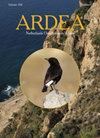Food Provisioning and Body Mass of Nestling Meadow Pipits and Cuckoos
IF 0.8
4区 生物学
Q3 ORNITHOLOGY
引用次数: 0
Abstract
Common Cuckoos Cuculus canorus are obligate brood parasites, laying eggs in nests of other species. Cuckoo nestlings are often thought to be insatiable, compared to host broods. However, in Reed Warblers Acrocephalus scirpaceus and a few other species, cuckoo nestlings are fed at most only as frequently as a host brood. To add to the small body of knowledge on feeding frequencies and body mass development of Cuckoo nestlings, I studied Cuckoos using another host, the Meadow Pipit Anthus pratensis, in the Dutch dunes (2019–2021). By filming feeding parents (hosts) I determined the provisioning frequency for broods of Pipits and for nestling Cuckoos. I found that nestling Cuckoos receive on average fewer feeds per hour than broods of Meadow Pipits. Furthermore, overall Cuckoos received as many feeds during their 22-day nestling period as a brood of Pipits during their 13 days in the nest. At 13 days of age (day 1 is the day of hatching), the single Cuckoo was as heavy as a brood of four Meadow Pipits. At 22 days, the maximum weights of the nestling Cuckoos were greater than the Meadow Pipit broods and varied between 91 and 105 g. Thus, although Cuckoos are being fed less frequently, young Cuckoos are heavier at fledging than a whole brood of Pipits. This could be because Cuckoos are fed larger prey. Alternatively, Cuckoos may require less food because their thermoregulatory costs could be smaller: they have almost black skin which absorbs solar radiation efficiently, do not have to compete with siblings in the nest and, once older and feathered, have a smaller surface-to-volume ratio than a Pipit brood of four nestlings.雏鸟草地鹨和杜鹃的食物供给和体重
常见的杜鹃Cuculus canorus是专性繁殖寄生虫,在其他物种的巢穴中产卵。与宿主相比,布谷鸟的雏鸟通常被认为是贪得无厌的。然而,在Reed Warblers Acrochalus scirpaceus和其他一些物种中,杜鹃雏鸟的喂养频率最多只能与宿主雏鸟一样高。为了补充关于杜鹃雏鸟进食频率和体重发育的少量知识,我在荷兰沙丘使用了另一种宿主——草地皮蜂(Meadow Pipit Anthus pratensis)对杜鹃进行了研究(2019-2021)。通过拍摄喂养父母(宿主)的过程,我确定了琵琶窝和巢中杜鹃的供应频率。我发现,筑巢的布谷鸟平均每小时接受的饲料比草地琵琶鸟少。此外,总的来说,布谷鸟在22天的筑巢期内接受的饲料与在13天的筑巢期间接受的一窝皮皮鸟的饲料一样多。在13天大的时候(第1天是孵化的日子),这只布谷鸟的体重和四窝草地皮皮鸟一样重。在22天时,筑巢的杜鹃鸟的最大重量大于草地皮皮鸟的窝重,在91至105克之间变化。因此,尽管杜鹃鸟的喂食频率较低,但幼鸟在孵化时比整窝皮皮鸟更重。这可能是因为布谷鸟吃的是更大的猎物。或者,布谷鸟可能需要更少的食物,因为它们的体温调节成本可能更小:它们几乎是黑色的皮肤,可以有效地吸收太阳辐射,不必在巢中与兄弟姐妹竞争,而且一旦长大并长出羽毛,它们的表面积比也比四只皮皮鸟的窝小。
本文章由计算机程序翻译,如有差异,请以英文原文为准。
求助全文
约1分钟内获得全文
求助全文
来源期刊

Ardea
生物-鸟类学
CiteScore
2.10
自引率
0.00%
发文量
49
审稿时长
>12 weeks
期刊介绍:
Ardea is the scientific journal of the Netherlands Ornithologists'' Union, and is published since 1912. The journal welcomes manuscripts reporting significant new findings in ornithology, in particular those covering the ecology, life history, and evolution of birds, and including sound descriptive work. Ardea publishes Original research papers, Short notes and Book reviews. In addition to the regular three issues per year, Ardea publishes specials that contain conference or workshop proceedings (produced on request).
 求助内容:
求助内容: 应助结果提醒方式:
应助结果提醒方式:


